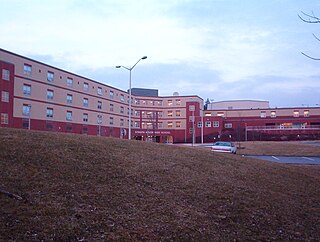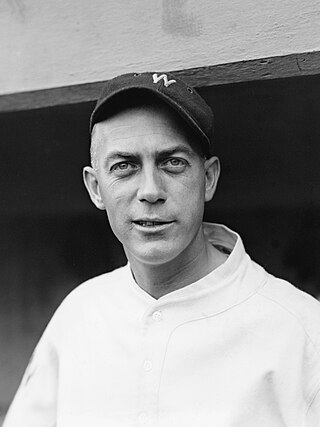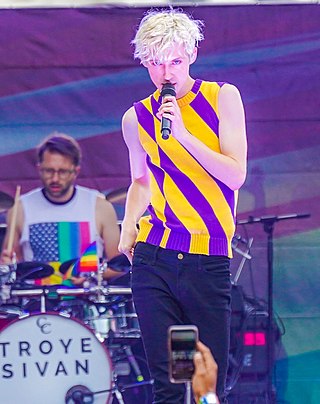
Swarthmore is a borough in Delaware County,Pennsylvania,United States. Swarthmore was originally named "Westdale" in honor of noted painter Benjamin West,who was one of the early residents of the town. The name was changed to "Swarthmore" after the establishment of Swarthmore College. The borough population was 6,194 as of the 2010 census.

Strath Haven High School is a four-year public high school in Wallingford,Delaware County,Pennsylvania,enrolling about 1,200 students. SHHS is the only high school in the Wallingford-Swarthmore School District. The school exhibits particular excellence in its special education program,connections to Swarthmore College and technical schools,and strong music and football programs. As of 2020,the current principal is Greg Hilden.

Pius Louis Schwert was an American politician and professional baseball player. He played for the New York Yankees of Major League Baseball and was a member of the United States House of Representatives from New York's 42nd congressional district.

William Winston Roper was an American football,basketball,and baseball player and coach. He served as the head football coach at the Virginia Military Institute (1903–1904),Princeton University,the University of Missouri (1909),and Swarthmore College (1915–1916),compiling a career college football record of 112–38–18. Roper's Princeton Tigers football teams of 1906,1911,1920,and 1922 have been recognized as national champions. His 89 wins are the most of any coach in the history of the program. Roper was also the head basketball coach at Princeton for one season in 1902–03,tallying a mark of 8–7. Roper played football as an end,basketball,and baseball as an outfielder at Princeton,from which he graduated in 1902. He was inducted into the College Football Hall of Fame as a coach in 1951.

George Anthony Mogridge was an American professional baseball pitcher. He played in Major League Baseball for the Chicago White Sox (1911–12),New York Yankees (1915–20),Washington Senators (1921–25),St. Louis Browns (1925),and Boston Braves (1926–27). Mogridge threw the first no-hitter for the Yankees franchise in 1917 and was a member of the 1924 World Series champions with the Senators.

Twink is gay slang for a man who is usually in his late teens to twenties whose traits may include a slim to average physique,a youthful appearance,little or no body hair,and flamboyancy. Twink is used both as a neutral descriptor,which can be compared with bear,and as a pejorative.
The 1900 Delaware football team represented Delaware College—now known as the University of Delaware–as an independent during the 1900 college football season. Led by fourth-year head coach Herbert Rice,Delaware compiled a record of 2–3–1.
The 1918 League Island Marines football team represented the United States Marine Corps stationed at the League Island Navy Yard in Philadelphia during the 1918 college football season. The team was coached by Byron W. Dickson. A game scheduled for October 19 against Villanova was cancelled due to Spanish flu quarantine.
The 1918 Swarthmore Quakers football team was an American football team that represented Swarthmore College as an independent in the 1918 college football season. In their second season under head coach Leroy Mercer,the Quakers compiled a 4–2 record and outscored opponents by a total of 116 to 38.
The 1942 Delaware Fightin' Blue Hens football team was an American football team that represented the University of Delaware in the 1942 college football season. In its third season under head coach William D. Murray,the team compiled an 8–0 record,shut out five of eight opponents,and outscored all opponents by a total of 196 to 28.
The 1898 Swarthmore Quakers football team was an American football team that represented Swarthmore College as an independent during the 1898 college football season. The team compiled a 9–2 record and outscored opponents by a total of 152 to 64. Jacob K. Shell was the head coach.
The 1901 Swarthmore Quakers football team was an American football team that represented Swarthmore College as an independent during the 1901 college football season. The team compiled an 8–2–2 record and outscored opponents by a total of 148 to 89. George H. Brooke was the head coach.
The 1916 Swarthmore Quakers football team was an American football team that represented Swarthmore College as an independent during the 1916 college football season. The team compiled a 6–1–1 record and outscored opponents by a total of 94 to 45. Bill Roper was the head coach.
The 1919 Swarthmore Quakers football team was an American football team that represented Swarthmore College as an independent during the 1919 college football season. The team compiled a 7–1 record and outscored opponents by a total of 145 to 79. Leroy Mercer was the head coach.
The Swarthmore football team represented Swarthmore College in American football. Swarthmore was the 15th oldest college football program in the United States. The football program started in 1878 with a game against Penn. The program played no more than two games per year until 1885 when it played a six-game schedule. There was no team in 1880 and 1881. The team did not hire a coach until 1888 when Jacob K. Shell began his 11-year tenure as head coach. This article covers the program's early years prior to the hiring of Shell as the school's first head football coach.
The 1899 Swarthmore Quakers football team was an American football team that represented Swarthmore College as an independent during the 1899 college football season. The team compiled an 8–1–2 record. George H. Brooke was the head coach.
The 1907 Swarthmore Quakers football team was an American football team that represented Swarthmore College as an independent during the 1907 college football season. The team compiled a 6–2 record and outscored opponents by a total of 150 to 53. George H. Brooke was the head coach.
The 1910 Swarthmore Quakers football team was an American football team that represented Swarthmore College as an independent during the 1910 college football season. The team compiled a 5–3 record and outscored opponents by a total of 144 to 59. George H. Brooke was the head coach.
The 1895 Swarthmore Quakers football team was an American football team that represented Swarthmore College as an independent during the 1895 college football season. The team compiled a 7–4–1 record and was outscored by a total of 204 to 173. Jacob K. Shell was the head coach.
The 1917 Swarthmore Quakers football team was an American football team that represented Swarthmore College as an independent during the 1917 college football season. The team compiled a 6–2 record and outscored opponents by a total of 238 to 40. Bill Roper was the head coach.







